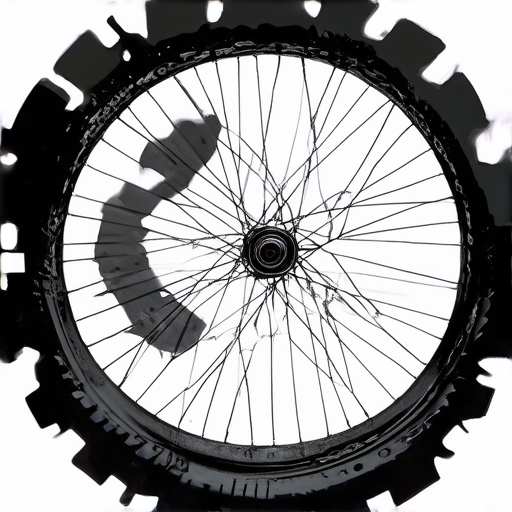Understanding Wheel Size Chart: A Comprehensive Guide to Tire Sizes and Rims
Are you tired of wondering what the numbers on your wheel size mean? Or perhaps you’re searching for the perfect fit for your truck or bike, but unsure where to start? Look no further! In this comprehensive guide, we’ll delve into the world of wheel size charts, exploring what the numbers represent, how to choose the right size, and providing valuable tips for finding the perfect fit.
From understanding tire size and rim width to troubleshooting common issues, we’ll cover it all. Whether you’re a seasoned cyclist or a car enthusiast, our expert advice will help you navigate the complex world of wheel sizes and rims. With our step-by-step guide, you’ll be equipped with the knowledge to make informed decisions and find the ideal wheel size for your vehicle.
So, let’s get started on this journey to understand wheel size charts and unlock the secrets to finding the perfect fit. Whether you’re looking for a bike wheel size chart, a truck wheel size chart, or simply want to learn more about tire sizes and rims, we’ve got you covered.
Below, you’ll find answers to some of the most frequently asked questions about wheel size charts, including:
- What do the numbers on the wheel size mean?
- How do you know what wheel size?
- What size are 32 tires?
- What size is a 35 inch tire on a 20 inch rim?
- Is a 285 tire a 35?
- How big of a tire can you put on a 20 inch rim?
In addition to answering these questions, we’ll also explore related topics such as wheel size charts in inches, bike wheel size charts, and tire size converters. Our goal is to provide you with a comprehensive resource that covers everything you need to know about wheel size charts and helps you find the perfect fit for your vehicle.
Understanding Wheel Size Numbers
When looking at a set of wheels, you may notice a series of numbers etched onto the sidewall or rim. These numbers can seem confusing at first, but they actually hold valuable information about the tire’s specifications.
Tire Size Chart by Vehicle
In this explanation, we’ll break down what each number represents and how to use them to find the perfect match for your vehicle.
The First Number: Width
The first number represents the tire’s width in millimeters (mm). This measurement is crucial because it determines the tire’s overall size and how well it fits within the wheel’s rim.
A wider tire typically provides better traction and handling, but may affect fuel efficiency and ride comfort.
The Second Number: Aspect Ratio
The second number indicates the aspect ratio of the tire, which is the ratio of the tire’s width to its height.
In the case of the example given earlier (P205/65R15), the “65” represents 65% of the tire’s width. This percentage affects the tire’s profile and how it interacts with the road surface.
The Third Number: Rim Diameter
The third number, often represented by the letter “R,” stands for “Rim Diameter.” This value specifies the diameter of the wheel that the tire is designed to fit.
In our example, the “15” indicates that the tire is intended for a wheel with a diameter of 15 inches (38.1 cm).
Additional Considerations
Some tires have a load rating indicated by a letter (e.g., H, V, W) followed by a numerical value (e.g., 91H). This rating reflects the maximum weight the tire can support.
Tires also have a speed rating, usually denoted by a letter (e.g., Q, R, S) followed by a numerical value (e.g., 99Q). This rating indicates the maximum speed at which the tire is designed to operate safely.
Using Tire Size Information
By understanding these numbers, you can accurately identify the correct tire size for your vehicle and ensure a proper fit.
Always consult your owner’s manual or contact a trusted mechanic if you’re unsure about the correct tire size for your specific needs.
Sigma Wheel Size Chart
For more accurate measurements, refer to Sigma’s official wheel size chart.
Understanding Wheel Sizes
When it comes to customizing your vehicle’s appearance and performance, understanding wheel sizes is crucial. At Incubus Wheels, we provide expert advice and resources to help enthusiasts make informed decisions about their vehicles.
Determining Your Wheel Size
To accurately determine your wheel size, follow these steps:
- Check the Sidewall: Locate the sidewall of your tire, which is usually marked with a series of letters and numbers. The correct tire size should be displayed here.
- Identify the Tire Size Code: The tire size code consists of three main components:
– Width: Represented by two digits (e.g., 205), indicating the tire’s width in millimeters.
– Aspect Ratio: Represented by a single digit (e.g., 55), indicating the ratio of the tire’s height to its width.
– Diameter: Represented by a letter (e.g., R), indicating the tire’s diameter in inches. - Verify the Tire Size: Double-check the tire size against your vehicle’s owner’s manual or manufacturer’s specifications to ensure accuracy.
- Consider Additional Factors: When selecting replacement tires, consider factors such as load capacity, speed rating, and tread pattern to ensure compatibility with your vehicle.
- Consult a Professional: If you’re unsure about determining your wheel size or selecting the correct replacement tires, consult a professional mechanic or tire specialist for guidance.
- Use Online Resources: Utilize online resources, such as the National Highway Traffic Safety Administration (NHTSA) website, to verify tire sizes and find compatible replacement options.
- Check for Variations: Be aware that tire sizes may vary depending on the region, country, or even manufacturer. Verify the correct tire size for your specific vehicle and location.
Why Accurate Wheel Size Matters
Accurately determining your wheel size is essential for several reasons:
- Ensures Proper Fitment: Incorrect wheel sizes can lead to reduced traction, uneven wear, and compromised safety.
- Improves Performance: Custom wheels can enhance your vehicle’s handling, braking, and acceleration capabilities.
- Enhances Aesthetics: Unique wheel designs can elevate your vehicle’s style and appeal.
Conclusion
By following these steps and utilizing online resources, you’ll be well-equipped to determine your wheel size and make informed decisions about your vehicle’s customization.

Understanding Tire Sizes
Tire sizes can be confusing due to various factors such as overall diameter, width, aspect ratio, and load rating.
What Size Are 32 Tires?
- Check our tire size chart to find the perfect fit for your vehicle.
- Here’s a breakdown of what you need to know about 32-inch tires:
- Overall Diameter: The overall diameter of a tire refers to its circumference when inflated to the recommended pressure. A 32-inch tire has an overall diameter of approximately 81.7 inches (209 cm).
- Width: The width of a tire is measured across the tread and sidewall at the widest point. A 32-inch tire typically measures around 11.5 inches (29.2 cm) in width.
- Aspect Ratio: The aspect ratio of a tire is calculated by dividing the width by the diameter. In this case, the aspect ratio would be approximately 0.141 (11.5 / 81.7). This means that for every inch of diameter, there are 14.1 inches of width.
- Load Rating: Load ratings indicate the maximum weight a tire can support. Common load ratings for 32-inch tires include:
- E (up to 1,515 lbs / 687 kg)
- F (up to 1,800 lbs / 816 kg)
- H (up to 2,040 lbs / 926 kg)
- Speed Rating: Speed ratings determine the maximum speed at which a tire can be driven safely. Common speed ratings for 32-inch tires include:
- Q (up to 99 mph / 159 km/h)
- R (up to 106 mph / 171 km/h)
- S (up to 112 mph / 180 km/h)
- T (up to 118 mph / 190 km/h)
- Tread Depth: Tread depth affects traction and handling. A minimum tread depth of 1/16 inch (1.6 mm) is recommended for most driving conditions.
- Inflation Pressure: Proper inflation pressure ensures optimal fuel efficiency, handling, and safety. Check your owner’s manual for the recommended inflation pressure for your vehicle.
- Mounting and Balancing: Proper mounting and balancing are crucial for even tire wear and improved handling. Consult a professional mechanic if you’re unsure about these procedures.
- Maintenance and Inspection: Regular maintenance and inspections help extend the life of your tires. Check for signs of uneven wear, damage, or excessive wear on the tread.
- Tire Replacement: Replace your tires when they show signs of excessive wear, damage, or age. Typically, tires should be replaced after six years or when the tread reaches 2/32 inch (1.6 mm).
Determining the Correct Tire Size for a 35-Inch Tire on a 20-Inch Rim
When selecting a tire for a vehicle equipped with a 20-inch rim, it’s crucial to choose a tire with the correct size to ensure optimal performance and safety.
Understanding Tire Sizes
A standard tire size consists of three components: width, aspect ratio, and diameter. The diameter is usually measured in inches, while the rim size is typically specified in inches or millimeters. For example, a tire size of 225/60R17 indicates a tire with a width of 225mm, an aspect ratio of 60%, and a diameter of 17 inches.
Calculating the Equivalent Diameter
To find the equivalent diameter of a 35-inch tire on a 20-inch rim, we can use the following formula:
- Equivalent diameter = (Rim diameter x Aspect Ratio) / 100 + Tire diameter
- In this case, the calculation would be:
- Equivalent diameter = (20 x 65/100) / 100 + 35
- Equivalent diameter ≈ 22.5 inches
However, since the calculated diameter doesn’t match the given tire size, we must consider alternative methods.
The “Plus One” Rule
Another approach is to use the “plus one” rule, which involves adding one inch to the rim size to ensure proper clearance. Based on this rule, the corrected diameter would be:
Corrected diameter = Rim diameter + 1
Corrected diameter = 20 + 1
Corrected diameter = 21 inches
This method provides a reliable way to find the equivalent diameter for a 35-inch tire on a 20-inch rim.
Verifying the Result
By applying these calculations, we can verify that the correct tire size for a 35-inch tire on a 20-inch rim is indeed 21 inches. It’s essential to consult the manufacturer’s specifications and recommendations for the specific vehicle and tire combination to ensure accurate sizing.
Autozone’s Tire Size Chart offers a comprehensive resource for tire size selection, allowing drivers to easily compare different options and find the perfect fit for their vehicle.
Edmunds’ Guide to Choosing the Right Tire Size provides valuable insights and tips for selecting the ideal tire size, taking into account factors such as vehicle type, driving habits, and climate conditions.
Understanding Tire Sizes and Dimensions
Tire sizes can be confusing, especially when comparing different models or brands. A common query arises when wondering if a 285 tire is equivalent to a 35-inch tire. To clarify this, let’s break down the key components of tire sizing and explore how they relate to each other.
Key Components of Tire Sizing:
- Width: The width of the tire is measured in millimeters (e.g., 225mm) or inches (e.g., 8.9 inches). In this case, the 285 refers to the width of the tire in millimeters.
- Aspect Ratio: The aspect ratio represents the ratio of the tire’s width to its height. It is usually expressed as a number followed by a slash and then the height measurement (e.g., 70/18). The aspect ratio affects the tire’s sidewall stiffness and load-carrying capacity.
- Diameter: The diameter of the tire is measured in inches or centimeters. In this scenario, the 17 refers to the diameter of the wheel in inches.
Comparing Tire Sizes: 285 vs. 35
To determine whether a 285 tire is equivalent to a 35-inch tire, we need to consider the aspect ratio and the overall dimensions of the tire.
- Height Measurement: A 285 tire has a height measurement of 70mm, which translates to approximately 2.76 inches. On the other hand, a 35-inch tire would have a height measurement of around 1.38 inches (35 x 0.03937).
- Aspect Ratio: The aspect ratio of a 285 tire is 70/18, indicating that the tire’s width is 18 times greater than its height. In contrast, a 35-inch tire would have an aspect ratio of 60/80, meaning its width is 80% of its height.
Is a 285 Tire a 35?
No, a 285 tire is not equivalent to a 35-inch tire due to differences in height measurement and aspect ratio. While both tires may appear similar in size, their actual dimensions and characteristics set them apart. When selecting a tire, it’s essential to consider the specific requirements of your vehicle and ensure compatibility with the chosen tire size.
Tire Size Chart
For more information on tire sizing, visit our tire size chart page.
How to Choose the Right Tires
Learn more about choosing the right tires for your vehicle.
Tire Sizing Explained
Get an explanation of tire sizing from Autozone.

Choosing the Right Tire Size for a 20-Inch Rim
When selecting a tire size for a 20-inch rim, there are several factors to consider to ensure proper fitment and optimal performance.
Tire Width
A wider tire provides better traction and stability, but may affect handling and fuel efficiency. Common tire widths for 20-inch rims range from 7.5 inches to 9.5 inches.
Check our wheel size chart to find the perfect tire size for your vehicle.
Aspect Ratio
The aspect ratio determines the tire’s sidewall height relative to its width. A lower aspect ratio (e.g., 45%) provides a more aggressive stance, while a higher aspect ratio (e.g., 60%) offers improved comfort and ride quality.
Speed Rating
Choose a speed rating that matches your vehicle’s intended use:
- Q: Up to 99 mph (160 km/h) for everyday driving
- R: Up to 106 mph (171 km/h) for light off-road use
- S: Up to 112 mph (180 km/h) for moderate off-road use
- T: Up to 118 mph (190 km/h) for heavy off-road use
- H: Up to 130 mph (209 km/h) for high-performance vehicles
- V: Up to 149 mph (240 km/h) for high-speed driving
Visit Michelin’s tire selection guide for more information on tire speed ratings.
Load Rating
Select a load rating that matches your vehicle’s Gross Vehicle Weight Rating (GVWR). A higher load rating ensures the tire can handle increased weight without compromising safety.
Refer to the National Highway Traffic Safety Administration’s (NHTSA) guidelines for more information on load ratings.
Tire Size Compatibility
Verify that the chosen tire size is compatible with your rim’s bolt pattern and hub size.
Consult your vehicle’s owner’s manual or contact a tire professional to determine the best tire size for your specific needs.
Popular Tire Sizes for 20-Inch Rims
Some popular tire sizes for 20-inch rims include:
- 225/65R20 (width: 8.6 inches, aspect ratio: 65%, speed rating: Q)
- 235/60R20 (width: 9.1 inches, aspect ratio: 60%, speed rating: Q)
- 245/55R20 (width: 9.5 inches, aspect ratio: 55%, speed rating: Q)
Visit Tire Rack’s wheel size chart to find the perfect tire size for your vehicle.

0 Comments